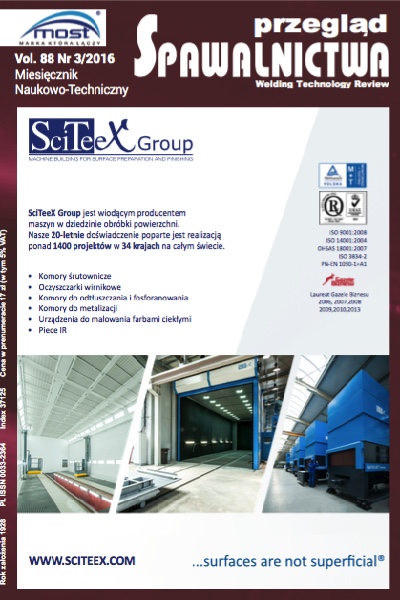Stan warstwy wierzchniej po laserowej oraz laserowo-mechanicznej modyfikacji powierzchni
Main Article Content
Abstract
W pracy przedstawiono analizę stanu warstwy wierzchniej po laserowym stopowaniu stali Stellitem 6 oraz obróbce hybrydowej łączącej laserowe stopowaniem z obróbką nagniataniem. Obróbka hybrydowa prowadzona była na stanowisku laserowym. Do realizacji procesu nagniatania powierzchni wykorzystano głowicę do nagniatania ślizgowego umożliwiającą obróbkę w podwyższonych temperaturach jak i na zimno. Ocenę efektów obróbki hybrydowej przeprowadzono na podstawie badań chropowatości, mikrostruktury, mikrotwardości oraz badań naprężeń własnych.
Surface integrity after laser and laser-mechanical surface modification
Abstract
The results of experiments on the application of the new hybrid method, which combines the laser alloying process with slide burnishing, were presented. Both treatments were performed on the laser stage in one operation. The experiments were done on carbon steel alloyed with Stellite 6. The results of analysis of the surface roughness, microstructure, microhardness and residual stresses in surface layer after the laser alloying process and laser alloying combined with burnishing were presented.
Downloads
Article Details
Creative Commons CC BY 4.0 https://creativecommons.org/licenses/by/4.0/
Welding Technology Review (WTR) articles are published open access under a CC BY licence (Creative Commons Attribution 4.0 International licence). The CC BY licence is the most open licence available and considered the industry 'gold standard' for open access; it is also preferred by many funders. This licence allows readers to copy and redistribute the material in any medium or format, and to alter, transform, or build upon the material, including for commercial use, providing the original author is credited.
References
J.R. Robinson A. B. Van Brussel, J. Th.M. De Hosson, R.C. Reed, X ray measurement of residual stresses in laser melted Ti-6Al-V alloy, Material Science and Engineering A208, s. 143-147, 1996.
B.G. Gireń, M. Szkodo, J Steller, The influece of rsidual stresses on cavitation resistance of metals- an analysis based on invesigations of metals remelted by laser beam and optical discharge plasma, Wear233-235, s.86-92, 1999.
H. Gripenberg, et al. Prediction and Measurement of Residual Stresses in Cladded Steel, Materials Science Forum, vol. 404-407, s. 861-866, 2010.
J. Grum, M. Znidarsic, Strain Measurement during Laser Surface Cladding of Low Carbon Steel and Analisis of Residual Stresses, Materials Science Forum, vol. 404-407, s. 437-444.
Cheng W., Finnie I., Gremaud M., Rosselet A., Streit R.D.: The Compliance Method for Measurement of Near Surface Residual Stresses - Application and Validation for Surface Treatment by Laser and Shot-Peening. Transactions of the ASME, vol. 116, s. 1242-253, 1994.
M. Ignatiev, E Kovalev, I. Melekhin, I. Sumurov , S. Surlese, Investigation of the hardening of titanium alloy by laser nitriding. Wear, vol.166, s. 233-236, 1993.
J. Th. M. De Hosson, J Noordhuis, Surface Modification by Means of Laser Melting Combined with Shot Peening: a Novel Approach. Material Science and Engineering, vol. A121, 1989.
J.P Kruth., H.K Tonshoff., F. Klocke, Surface and Sud-Surface Quality in Material Removal Processes for Tool Making. 12th International Symposium for Electomachining (ISEM), Aachen, Germany, 11-13 May 1998.
M. Jankowiak Laserowe wspomaganie toczenia twardej ceramiki Si3N4. Wybrane Zagadnienia Obróbek Skoncentrowaną Wiązką Energii (Konferencja EM 2003), Bydgoszcz, s. 184-192, 2003.
J. Radziejewska, Laserowa modyfikacja właściwości warstwy wierzchniej wspomagana nagniataniem. Prace IPPT - PAN, Warszawa 3/2011, ISBN 978-83-89687-70-8.
J. Radziejewska, S. Skrzypek, Microstructure and residual stresses in surface layer of simultaneously laser alloyed and burnished steel. J of Materials Processing Technology, vol. 209, s. 20472056, 2009.
